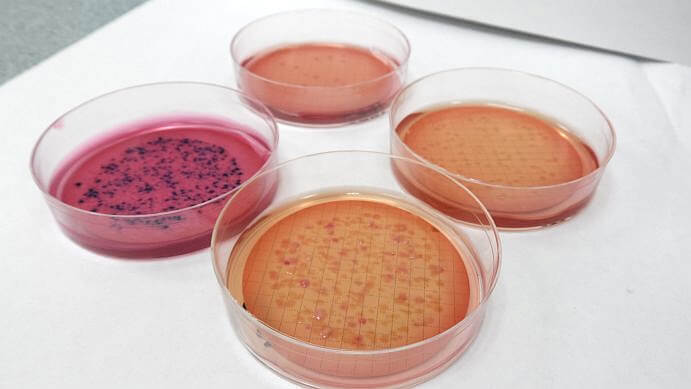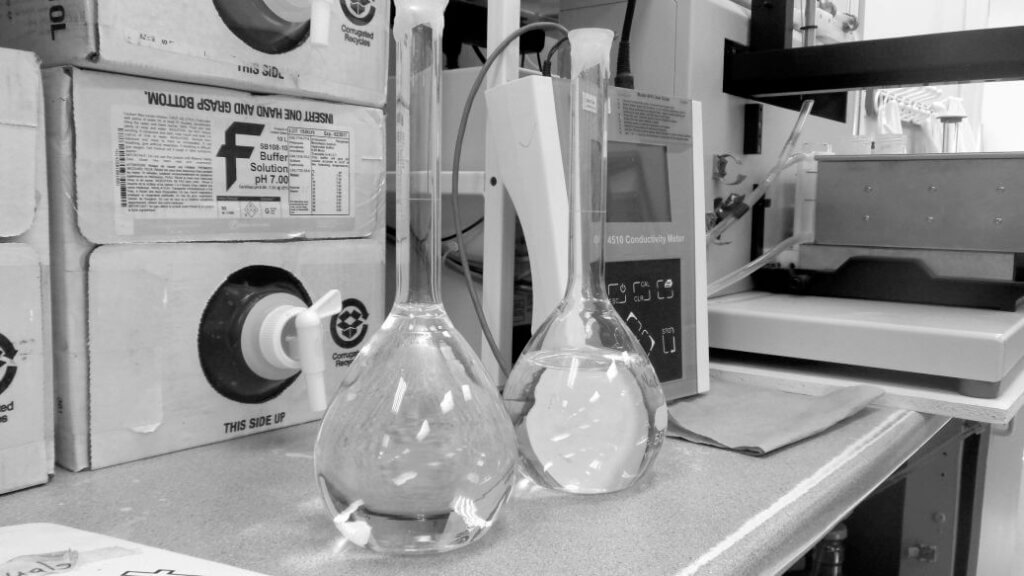Our laboratory and qualified analysts are equipped to perform the following analyses:
Microbiology
Potability Testing
- Total Coliforms (TC)
- Total coliforms indicate the possible presence of pathogenic bacteria. If Total coliforms are detected, it is reason to disinfect the water supply. Bacteria belonging to this group can also be naturally found in soils.
- Escherichia coli (EC)
- Escherichia coli bacteria (commonly referred to as E. coli) is a bacteria that originates from the feces of warm blooded mammals. It is used to indicate the possible presence of septic contamination. E. coli bacteria should not be detectable in drinking water. If detected the well should be immediately disinfected and then tested several times for bacteria.
- General Bacteria Population (GBP)
- Aerobic bacteria is not considered harmful for drinking. However, when present, the well should be examined for structural faults and should be decontaminated. Residential wells should be monitored on a quarterly to semi-annual basis for coliform contamination.
- Heterotrophic Plate Count (HPC)
- This laboratory technique is used to estimate the number of live heterotrophic bacteria in water. HPC is used to monitor changes during water treatment and distribution (plant efficiency). Results from this test are not an indicator of potential adverse human health effects.

Other Microbiology Tests
- Fecal Coliforms (FC)
- Fecal coliforms are a group of coliform bacteria that originate in the gastrointestinal tract of warm blooded animals and humans. Escherichia coli and Fecal streptoccocus are both fecal coliforms.
- Fecal streptococcus (FS)
- Fecal streptococcus is a fecal coliform that is very resistant to changes and also an indicator of fecal contamination in bodies of water.
- Sterilizer Monitoring Program see Sterilizer Monitoring Page
Chemical Analysis
- Alkalinity
- Alkalinity is a measure of the resistance of the water to the effects of acids added to water. Water with low alkalinity may tend to accelerate natural corrosion leading to “red water” problems whereas high alkalinity waters may produce scale incrustations on utensils, service pipes and water heaters.
- Ammonia (NH3)
- Ammonia is present naturally in surface and wastewaters. It is produced largely by deamination of organic nitrogen containing compounds and by hydrolysis of urea. At some water treatment plants ammonia is added to react with chlorine to form a combined chlorine residual.
- BOD5 / CBOD
- Measurement of oxygen consumed within a 5-day test period.
- Bromide
- Bromine (Bromide) is found in sea water and exists as the Bromide ion at a level of about 65 mg/L. Bromine has been used in swimming pools and cooling towers for disinfection, however use in drinking water is not recommended. Bromine is extremely reactive and corrosive, and will produce irritation and burning to exposed tissues. There is no maximum limit.
- Chloride
- Chloride is a common non-toxic material present in small amounts in drinking water and produces a detectable salty taste at the aesthetic objective level of 250 mg/L. Chloride can be the source of an unpleasant taste and high levels may indicate contamination from roads and septic systems. Can corrode pipes. Levels 5 – 20 mg/L are ideal for drinking water.
- Chlorine (Total & Free)
- The chlorination of water supplies and polluted waters serves primarily to destroy or deactivate disease-producing microorganisms.
- Conductivity
- Conductivity is a measure of ionic activity (ability of water to conduct a current). It is used to verify chemistry results. Natural water ranges between 50 – 1500 us/cm.
- Fluoride
- Where fluoride is added to drinking water, it is recommended that the concentration be adjusted to 0.5 – 0.8 mg/L, the optimum level for control of tooth decay. Where supplies contain naturally occurring fluoride at levels higher than 1.5 mg/L mg/L but less than 2.4 mg/L the Ministry of Health and Long-Term Care recommends an approach through local boards of health to raise public and professional awareness to control excessive exposure to fluoride from other sources. Levels above the MAC must be reported to the local Medical Officer of Health.
- Microcystins
- The maximum acceptable concentration in drinking water recommended by Health Canada and the Ontario Drinking Water Standards is 1.5 ppb of total microcystin-LR.
- Nitrate, Nitrite, Nitrate + Nitrite (NOx)
- Nitrates are present in water (particularly ground water) as a result of decay of plant or animal material, the use of agricultural fertilizers, domestic sewage or treated wastewater contamination, or geological formations containing soluble nitrogen compounds. Nitrite may occur in ground water, however if chlorination is practiced the nitrite will usually be oxidized to nitrate. Where both nitrate and nitrite are present, the total nitrate plus nitrite-nitrogen concentration should not exceed 10 mg/L.
- Organic Nitrogen
- Organic nitrogen compounds frequently contain amine groups which can react with chlorine and severely reduce its disinfectant power. Certain chlorinated organic nitrogen compounds may be responsible for flavour problems that are associated with chlorophenol. Taste and odour problems are common with organic nitrogen levels greater than 0.15 mg/L.
- Orthophosphate
- Orthophosphates applied to agricultural or residential cultivated land as fertilizers are carried into surface waters and to a lesser extent with melting snow. There is no set maximum limit. High levels of orthophosphate in wells may be an indicator of contamination from surface water runoff.
- pH
- pH is a parameter that indicates the acidity of a water sample. Recommended pH of drinking water should be between 6.5 and 8.5. Water with pH lower than 6.5 could lead to corrosion problems and pH higher than 8.5 can cause incrustation from minerals and bitter taste.
- Phenol
- A foul smelling chemical that can occur in natural waters from decompositon of aquatic vegetation. Phenol and its derivatives are used to fabricate resins, plastics and pharmaceuticals and are found in industrial effluents and domestic sewage.
- Phosphorus (Total and low-level)
- Phosphorus is a naturally occurring element essential to plant growth and microorganism activity. Phosphorus levels in the environment are increased significantly by man’s activities. Total phosphorus levels of less than 20 µg/L are suggested to prevent nuisance concentrations of algae.
- Resistivity
- Resistivity is a measure of a material’s property to oppose the flow of electric current. A high resistivity means that a material does not conduct well electric charge.
- Sulfate
- Sulfate is typically low in natural waters with the exception of sources near industries. Sulfate can also come from geological deposits. Can cause noticeable taste and smell. Can also cause health disorders at levels greater than 500 mg/L.
- Turbidity
- Turbidity is an important indicator of treatment efficiency and the efficiency of filters in particular. Turbidity in excess of 5.0 NTU becomes visible to the naked eye and as such a majority of consumers may object to its presence. Therefore, an aesthetic objective of 5.0 NTU has been set for all waters at the point of consumption.
- Total Dissoved Solids (TDS)
- The aesthetic objective for total dissolved solids in drinking water is 500 mg/L. The term “total dissolved solids” (TDS) refers mainly to the inorganic substances dissolved in water. The principal constituents of TDS are chloride, sulphates, calcium, magnesium and bicarbonates. The effects of TDS on drinking water quality depend on the levels of the individual components. Excessive hardness, taste, mineral deposition or corrosion are common properties of highly mineralized water. The palatability of drinking water with a TDS level less than 500 mg/L is generally considered to be good.
- Total Suspended Solids (TSS)
- Total suspended solids reflect particles in water greater then 1.5 micro meter in size. Total Solids is the term applied to the material residue left in the vessel after evaporation of a sample and its subsequent drying in an oven at a defined temperature. Total solids include Total Suspended Solids (TSS), the portion of total solids retained by a filter, and Total Dissolved Solids (TDS), the portion that passes through the filter.
- Total Solids (TS)
- Total solids is the term used to describe the total of all the solids in a known volume of sample after drying at 103 °C ± 2°C to a constant mass. The increase in mass of the container represents the total solids. This can be calculated from gravimetric measurements of TSS and TDS
- Total Kjeldahl Nitrogen (TKN)
- Total of organic nitrogen, ammonia (NH3) and ammonium (NH4+) analyzed in soil, water or wastewater. Monitoring and reporting TKN levels is often regulatory for water and sewage treatment plants.
- Volatile Suspended Solids (VSS)
- Volatile suspended solids is the term used to describe the weight loss after ignition of either TS, TSS or TDS at 550°C for 1 hour.


